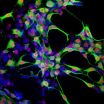Potential cause of severe sleep disorder discovered, implications for Parkinson's disease
2011-06-16
(Press-News.org) TORONTO, ON – Researchers at the University of Toronto are the first to indentify a potential cause for a severe sleep disorder that has been closely linked to Parkinson's disease and other neurodegenerative diseases.
"Our research is the first to establish a potential genetic link to human REM sleep behaviour disorder (RBD). That's important because between 60 and 80 per cent of people diagnosed with human RBD develop Parkinson's disease or other neurodegenerative disorders later in life," says Dr. John Peever, lead author of the study that recently appeared in The Journal of Neuroscience.
Rapid-eye-movement sleep behaviour disorder (RBD) is most often characterized by violent movements that occur during dreaming sleep, also called rapid-eye-movement sleep. People who suffer from RBD do not experience normal muscle paralysis that prevents them from enacting their dreams and they often hurt themselves or their bed partners with their rapid, forceful movements. In some cases, patients need to be tied to their bed to prevent serious injury to themselves or their bedpartners.
Peever's team focused on investigating a genetic cause of RBD because the underlying cause of this disorder is unknown. There is evidence indicating that reduced brain inhibition could cause RBD, so Peever's team genetically reduced brain inhibition in mice and then recorded their sleep and muscle activity.
"We found that mice with reduced brain inhibition acted just like human RBD patients and they moved violently during REM sleep," says Peever. "This link strongly suggests that patients with RBD may also have impaired brain inhibition."
They also found that RBD symptoms in mice could be alleviated by giving them clonazepam – a drug used to treat human RBD.
Peever's research underscores the importance of identifying a cause of RBD as 60 – 80 per cent of RBD sufferers subsequently develop Parkinson's.
"Treating RBD could have direct implications for understanding and perhaps treating Parkinson's disease," says Peever.
INFORMATION:
END
ELSE PRESS RELEASES FROM THIS DATE:
2011-06-16
DURHAM, NC – By shooting a beam of neutrinos through a small slice of the Earth under Japan, physicists say they've caught the particles changing their stripes in new ways. These observations may one day help explain why the universe is made of matter rather than anti-matter.
The T2K experiment has been using the Japan Proton Accelerator Research Complex, or J-PARC, located on the east coast, to shoot a beam of muon neutrinos 185 miles, or 295 kilometers, underground toward the Super-Kamiokande, or Super-K, detector in Kamioka, near Japan's west coast.
The goal of the ...
2011-06-16
CHICAGO (June 15, 2011) – Geisinger Health System vaccinated more than 92% of all employees against influenza this season, with a modification of a mandatory program. On average, fewer than half of all healthcare workers receive flu vaccinations.
In an article published in July's Infection Control and Hospital Epidemiology, the journal of the Society for Healthcare Epidemiology of America, Dr. Lisa Esolen demonstrated the effectiveness of Geisinger's influenza vaccination that helped achieve high rates of vaccine compliance for two consecutive years. This past season, ...
2011-06-16
GAINESVILLE, Fla. — Like rock stars of the rodent world, the flashiest performers of a Central American mouse species get the most attention from the ladies, a University of Florida study shows.
Neotropical singing mice woo their mates with high-pitched vocal trills, and a bravura performance attracts more interest from females, according to a study published online this week in the journal Animal Behaviour by doctoral candidate Bret Pasch and colleagues in the department of biology at the University of Florida.
The males' prowess could give female mice clues to a ...
2011-06-16
DURHAM, NC -- A person scanning baggage or X-rays stands a better chance of seeing everything they're searching for if they aren't feeling anxious, according to a new laboratory experiment.
Duke psychologists put a dozen students through a test in which they searched for particular shapes on a computer display, simulating the sort of visual searching performed by airport security teams and radiologists.
Stephen Mitroff, an assistant professor of psychology and neuroscience who led the experiment, says this area of cognitive psychology is important for improving homeland ...
2011-06-16
Have you ever thought you could lose weight and star on The Biggest Loser if you weren't so darned hungry all the time?
Unfortunately, the diets we turn to for help don't do the job. How often have you heard that weight loss is as simple as taking in fewer calories than you burn and--voila!--the pounds will come off?
It's actually a bit more complicated than that. Doctors used to think that a calorie was a calorie. It didn't matter if your diet plan called for eating 1,200 calories in Twinkies all day. If you cut out enough calories, you could lose weight. Now, they're ...
2011-06-16
Using sophisticated methods of dating rocks, a team including University of Southampton researchers based at the National Oceanography Centre, Southampton, have pinned down the timing of the start of an episode of an ancient global warming known as the Paleocene-Eocene thermal maximum (PETM), with implications for the triggering mechanism.
The early part of the Cenozoic era, which started around 65.5 million years ago witnessed a series of transient global warming events called hyperthermals. The most severe of these was the PETM at the Paleocene–Eocene boundary, around ...
2011-06-16
INDIANAPOLIS – Researchers have used cutting-edge stem cell technology to correct a genetic defect present in a rare blinding disorder, another step on a promising path that may one day lead to therapies to reverse blindness caused by common retinal diseases such as macular degeneration and retinitis pigmentosa which affect millions of individuals.
In a study appearing in an advance online publication of the journal Stem Cells on June 15, 2011, investigators used recently developed technology to generate induced pluripotent stem (iPS) cells from a human patient with an ...
2011-06-16
A new study in the Journal of Consumer Research explains why sad people are more likely to want to hug a teddy bear than seek out a visual experience such as looking at art. Hint: It has to do with our mammalian instincts.
"Human affective systems evolved from mammalian affective systems, and when mammals are young and incapable of thinking, their brain systems have to make these pups able to perform the 'correct' behavior," write authors Dan King (NUS Business School, Singapore) and Chris Janiszewski (University of Florida, Gainesville). One way the brain encourages ...
2011-06-16
When consumers think about the groups they belong to, they recall ads better, according to a new study in the Journal of Consumer Research.
"A key determinant of how much consumers remember from an ad is the connection between the ad content and the consumer's own self-concept," write authors Kathryn R. Mercurio (UCLA) and Mark Forehand (University of Washington, Seattle).
Consumers identify with many different demographic groups, such as race, gender, or age. They also identify with family role groups (mother, father, sister), or occupational groups such as lawyer, ...
2011-06-16
Strongly identifying with an organization or workplace can change people's lives in profound ways, according to a new study in the Journal of Consumer Research.
"Managers often hope that consumers identify with organizations they regularly patronize, and firms sometimes encourage labor to encourage employees to identify with firms they work for, because in both cases organizations benefit from such identification," write authors Melea Press and Eric J. Arnould (both University of Wyoming, Laramie). The authors focus on identification formation from the perspective of ...
LAST 30 PRESS RELEASES:
[Press-News.org] Potential cause of severe sleep disorder discovered, implications for Parkinson's disease


